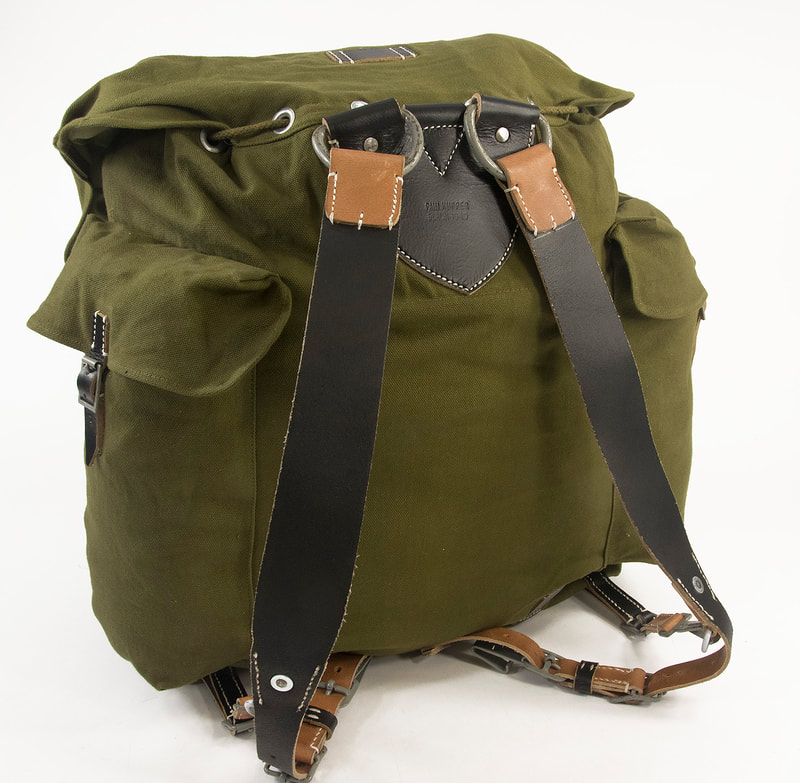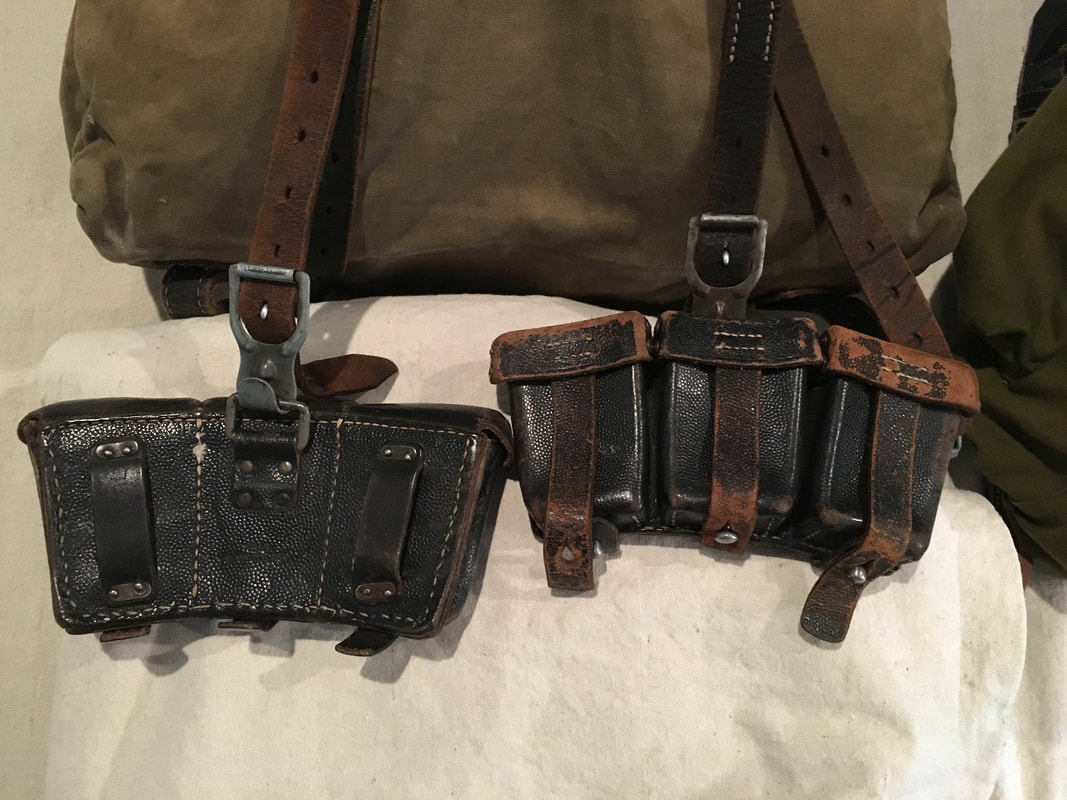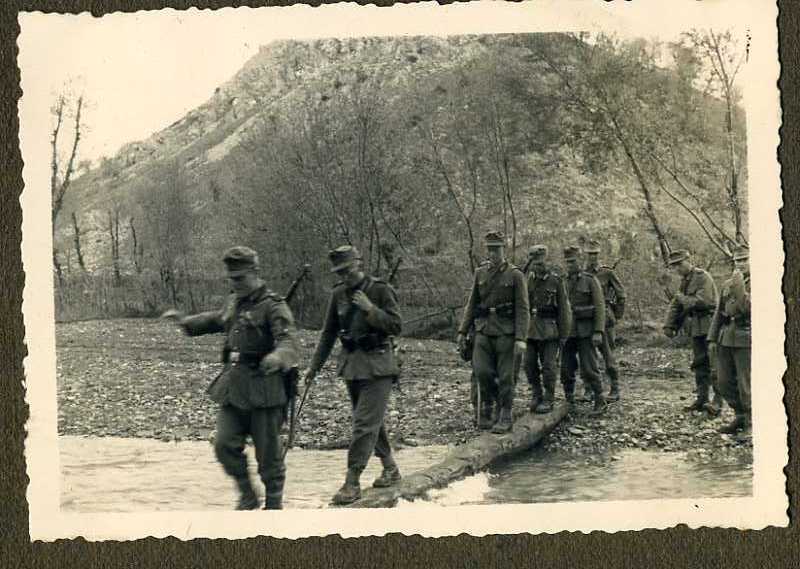Photographs of Approved Kit
This page illustrates in more detail the uniform and field gear items described on the Requirements page.
This is your unit endorsed visual guide to building your kit.
This is your unit endorsed visual guide to building your kit.
Wool Uniform:
M36 Feldblusen (tunic), M35 Berghosen (mountain trousers) in steingrau, Bergmutz (mountain cap), a parade Stahlhelm contrasts with one painted for combat, suspenders, enlisted belt and buckle with K98 pouches, M31 Kochgeschirr (original mess tin), M31 Brotbeutel (bread bag), 1 liter Feldflasch (mountain canteen), Bergschuhe (mountain boots), Wickelgemaschen (puttees), wool socks, wool gloves and the heavier service shirt. Missing are the gas mask canister and bayonet.
M36 Feldblusen (tunic), M35 Berghosen (mountain trousers) in steingrau, Bergmutz (mountain cap), a parade Stahlhelm contrasts with one painted for combat, suspenders, enlisted belt and buckle with K98 pouches, M31 Kochgeschirr (original mess tin), M31 Brotbeutel (bread bag), 1 liter Feldflasch (mountain canteen), Bergschuhe (mountain boots), Wickelgemaschen (puttees), wool socks, wool gloves and the heavier service shirt. Missing are the gas mask canister and bayonet.
Wool details: M36 Feldblusen showing insignia (Left) and internal suspenders with belt hooks (Right)
Wool sweater with wool socks and tocque.
Warm Weather Uniform
(click above to go to page with more detail)
HBT (Herringbone Twill) was introduced gradually after the war started. Below is the M40 tunic, M43 trousers,light cotton service shirt, tank undershirt, HBT Bergmutz, Low ankle boots, lighter wool socks and contents of opened mess kit.
(click above to go to page with more detail)
HBT (Herringbone Twill) was introduced gradually after the war started. Below is the M40 tunic, M43 trousers,light cotton service shirt, tank undershirt, HBT Bergmutz, Low ankle boots, lighter wool socks and contents of opened mess kit.
Below: Detail of mess tin contents. Efficient use of space and sound absorption of the notoriously noisy mess kit. Wrap the items in cloth to absorb sound. Handkerchief wraps the Spork and Campsuds; Hand towel wraps the Esbit stove and fuel. A modern sponge with a scubber side is useful and helps fill the space.
Mountaineering Items
Click on any photo to scroll through the gallery and view entire photos full size. Click these links for Rucksacks, Windjacket and Windbluse which have their own pages in more detail than shown here.
Below: Rucksacks and packing: Original 2 pocket ruck (early war) with reproduction 3 pocket ruck (mid war). Wool blanket, sleeping bag and air mattress were carried in the ruck as core contents. Equipment, ammunition, food, extra clothing were also stuffed in and equipment was strapped and hung off the external loops. The ruck replaced the Gebirgsjäger supply line once they were beyond the reach of vehicles and pack animals, which is why it was larger than the standard infantry ruck and assault packs. The sleeping bag, air mattress, flashlight and first aid kit are obviously modern. Also included are stuff sacks containing preferred items: extra bootlaces, matches, lighter, snow goggles, a carabiner with belt hooks, pocket knife and whistle attached, wallet, cigarettes, ID disc, small notebook and pencil for writing important details of terrain and for recording orders, a bag for extra ammunition. Toiletries are not shown here but would also be included. Band aids are for minor cuts to spare the first aid kit. Modern plastic bags are practical ways of keeping moisture out of important items.
Below: Rucksacks continued, Detail showing how the ruck straps attached to ammunition pouch loops and how field gear was attached to external ruck loops. Also shown is an original ice axe.
Mountaineering Equipment in Detail: Ski Equipment, Climbing Equipment, Accessories
Below are scans of pages from The German Army Mountain Soldier of World War II. This is an excellent reference on uniforms and equipment that is well-researched with contemporary photographs of originals.
Below are scans of pages from The German Army Mountain Soldier of World War II. This is an excellent reference on uniforms and equipment that is well-researched with contemporary photographs of originals.
Your browser does not support viewing this document. Click here to download the document.
Your browser does not support viewing this document. Click here to download the document.
Your browser does not support viewing this document. Click here to download the document.
Below: Various configurations of infantry field gear when a rucksack was not used. The gas mask and its canister were not carried into the mountains since the use of gas would have been ineffective in that environment. In lower elevations and later into the war, the Assault Pack was issued and regular infantry quickly adapted it into the variety of configurations that focused on practicality and reducing noise. The mess kit and gas canister were notoriously noisy. Removing the mess kit from the bread bag and strapping it onto the assault pack was one step toward quieter movement. Another was to abandon wearing the gas canister over the shoulder and strapping it to the assault pack or to the equipment belt.
Below: Various sleeping kit items. Wool blanket for barracks or outdoors. Homespun duvet with plush blanket inserted, Pillow in homespun cover. German sleeping bag from 1940's, believed to be Hitler Youth issued.
Following are original photographs. Note the prevalence of rucksacks and Bergmutzen while they are on the move. Helmets are either fixed on the ruck flap or over the left ammo pouch. Lots of M36 Feldblusen with mid-war 3 pocket large rucks. Canteens often clipped to belt hooks and NOT on the bread bag. No Y straps at all. Gas cans not visible. Bread bags here and there. These photos were part of an album, so we believe that this is all one theatre in different seasons. Steel towers and the tiled roof building would indicate southern Europe, probably Italy. Final photo shows NCO with mapcase attached by belt hooks and a bakelite binocular case.

































